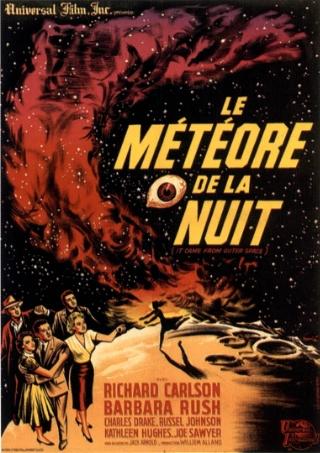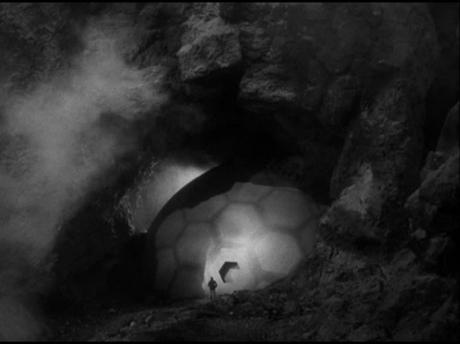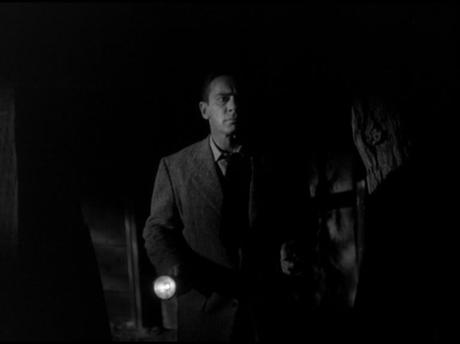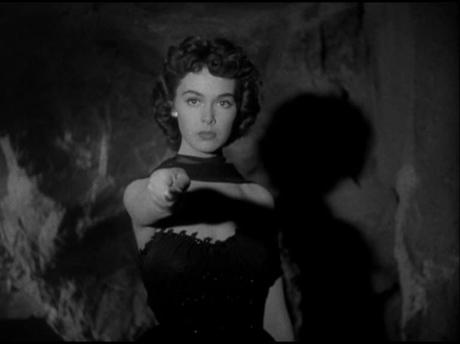
– It’s alive.
– And yet it looks so dead out there.
– Oh no, it’s alive and waiting for you, ready to kill you if you go too far. The sun will get you, or the cold at night. A thousand ways the desert can kill. Where are you? What do you look like? What am I supposed to be looking for? I know you’re out there, hiding in the desert. Maybe I’m looking right at you and don’t even see you…
Visitors to this site might get the impression I only watch or appreciate a narrow range of movies, westerns and noir thrillers in the main. Well those happen to be my favorites, and therefore get featured a lot, but it shouldn’t be taken as a dismissal on my part of other genres. The fact is I watch all kinds of stuff, even if it doesn’t get written up here with any kind of regularity. Sci-Fi has only made one other appearance on the site, despite the fact I do enjoy it, and I feel it’s time to offer some company to that solitary post. I should also say that Kristina’s recent flurry of Sci-Fi and horror/fantasy related posts over at Speakeasy encouraged me to do something about it. Let me say right away that my favorites in the genre can be found among the classic era material from the 50s and, to a lesser extent, the 60s and early 70s. As such, I’ve decided to run with It Came from Outer Space (1953), one of the best and most literate of the “fear of the unknown” variety.
Any movie with a relatively short running time owes it to the viewers to grab the attention as abruptly as possible, and this movie does just that by having a glowing spherical object hurtle menacingly towards the screen right at the beginning. We soon learn that this strange sight is an extraterrestrial spacecraft careering blindly towards the desert on the outskirts of a small Arizona town. Sand Rock is one of those close-knit communities where everyone knows everyone else, and strangers generally have to toil in order to overcome the inherent suspicion of the locals. John Putnam (Richard Carlson), an astronomer and relative newcomer, finds himself in that position when, along with his fiancée Ellen (Barbara Rush), he witnesses what looks like a meteor blazing its way across the night sky and ploughing into the arid wastelands beyond the town limits. Fortunately or unfortunately, depending on one’s perspective, Putnam is the first to explore the crater gouged out by the impact and also the only one to see the clearly alien craft that caused it. A major rock slide succeeds in burying all trace of the find, and leaves him in the unenviable position of trying to convince others of the significance of what’s just happened. Perhaps not unnaturally, his claims are met with almost universal skepticism, Ellen being the only one not to doubt him, and borderline hostility from one particular quarter. Matt Warren (Charles Drake) is the local sheriff who clearly has feelings for Ellen and this arguably colors his reaction to Putnam’s assertions. However, something otherworldly has landed in Sand Rock, something capable of assuming the form of whoever suits its purposes. Aside from the neat mirroring of attitudes – both Putnam and the alien interlopers are on the receiving end of essentially the same suspicion and paranoia – the plot develops in an interesting, and quite refreshing direction, in terms of the visitors’ motivations and objectives. Before all of this is resolved though, there’s plenty of opportunity for the suspense to build.

The 50s science fiction boom seems to have been a direct result of the mood of the times – a curious cocktail of fear and hope. There was the paranoia stemming from the dread of devastation raining down from the skies coupled with a wariness over the possibility of an enemy within. This was at least partly balanced by the optimism of the post-war era, where the flip side of the technological revolution was the realization that boundless possibilities for progressive discovery also existed. Putnam’s character, as much as the aliens themselves, could be said to represent these twin concepts, and I feel it’s to the filmmakers’ credit that it’s the positive rather than the reactionary aspect which is embraced in the end.
It Came from Outer Space was to be the first Universal picture shot in the new 3D process. I’ve only seen it flat and it plays fine that way, although there’s a documentary on the DVD which points out how certain shots (not just gimmicky, throwing stuff at the screen material) were carefully composed to highlight the added depth of the extra dimension. The film was shot in California, standing in for Arizona, and good use is made of the Mojave Desert locations. The sense of remoteness, and the attendant perils of such a harsh and bleak environment, is woven into the plot, notably through passages of associated dialog retained from Ray Bradbury’s original screen treatment. Although he had worked on a number of shorts, this was one of Jack Arnold’s earliest full length features, and his assurance as a director is already evident. Clifford Stine’s moody cinematography obviously helps things along, but Arnold sets everything up and keeps the story moving forward smoothly. Initially, it was planned not to show the aliens to the audience (a principle which I feel probably should have been adhered to) and focus on a combination of reaction shots and first person filming via a distorted lens. As it stands, I think some of the most effective scenes in the film are those where the threat is unseen – the sinister figures of Joe Sawyer and Russell Johnson silhouetted in a doorway, or a simple jump scare provoked by a light suddenly illuminating as mundane an object as a Joshua tree.

Richard Carlson had appeared in a whole variety of movies, some memorable and others less so, by the time this picture was made, and it introduced him to the Sci-Fi genre. He had the kind of square-jawed yet thoughtful features that lent themselves to playing heroes with a brain, a quality which would see him cast in a number of other films in this genre in the years to come. In the role of Ellen, Barbara Rush is asked to do little more than provide a supportive and sympathetic presence at first, but she later gets to have a little more fun as her own doppelgänger in the final act. Ms Rush was near the beginning of her long career in this movie and I’ve no doubt her composed performance helped raise her stock as an actress. While her cinema credits are impressive enough, she has worked extensively on TV, including a highly memorable part in a show I can’t seem to get away from mentioning of late – yes, it’s The Fugitive again. Charles Drake took on all kinds of roles over the years, as was the lot of contract actors, though I always feel he was at his best when cast as weaselly or less than sympathetic types. As such, playing the hot-headed, resentful sheriff suited him well and added an intriguing layer to the relationships at the center of the movie.

My DVD of It Came from Outer Space is the old Universal UK release, which is serviceable enough but could be improved. Personally, I’m not that bothered about the absence of a 3D version, although others will likely feel differently, but the open matte transfer is more disappointing. A film like this really needs to get a Blu-ray release in the correct widescreen ratio, and also provide the option of viewing it in 3D for those who wish to do so. On the plus side, there are some good extra features: a commentary track with Tom Weaver and a half-hour documentary on the film and it’s place in 50s Sci-Fi filmmaking. The film remains important as Jack Arnold’s first science fiction project, the genre his name is now most strongly associated with, and also for its position as an early classic in what has become a very crowded field over the years. I think the best, or most interesting, Sci-Fi films use their fantastic or otherworldly elements to tell us something about ourselves above all. It Came from Outer Space neatly challenges expectations and prejudices and encourages us to look within as much as without, which is one of the reasons I enjoy revisiting it. Recommended.
